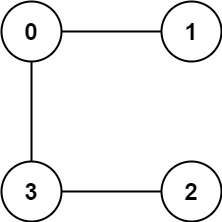913. Cat and Mouse
问题:
给定一个无向图,节点0~N-1
- mouse:从1出发-> 到达 0,win -> return 1
- cat:从2出发-> 到达mouse的当前位置,win(不能走 0 节点)-> return 2
- 若两者都无法win,且走完所有的节点,那么平局 tie。-> return 0
⚠️ 注意:
- mouse和cat都不能重复走同一个节点。
- mouse先出发。
Example 1: Input: graph = [[2,5],[3],[0,4,5],[1,4,5],[2,3],[0,2,3]] Output: 0 Example 2: Input: graph = [[1,3],[0],[3],[0,2]] Output: 1 Constraints: 3 <= graph.length <= 50 1 <= graph[i].length < graph.length 0 <= graph[i][j] < graph.length graph[i][j] != i graph[i] is unique. The mouse and the cat can always move.
example 1:

example 2:

解法:DFS+DP
状态:
- POS_mouse
- POS_cat
- time(steps)
dp[m][c][t]:mouse在m节点,cat在c节点,在t步时(以后各种走法之后),是谁输谁赢
- 0:平局
- 1:mouse赢
- 2:cat赢
选择(状态转移):dp[m][c][t] = ?
- 当前是mouse走:
- 若下一步 dp[m_next][c][t+1]
- 有一种mouse能赢的方法:则 dp[m][c][t] = 1(mouse赢)
- 所有都不能使得mouse赢,但存在可以平局的方法:则 dp[m][c][t] = 0(平局)
- 既不能赢,也不能平局,所有可能都是输:则 dp[m][c][t] = 2(mouse输)
- 若下一步 dp[m_next][c][t+1]
- 当前是cat走:
- 若下一步 dp[m][c_next][t+1]
- 有一种cat能赢的方法:则 dp[m][c][t] = 2(cat赢)
- 所有都不能使得cat赢,但存在可以平局的方法:则 dp[m][c][t] = 0(平局)
- 既不能赢,也不能平局,所有可能都是输:则 dp[m][c][t] = 1(cat输)
- 若下一步 dp[m][c_next][t+1]
base:
- t==2*N,步数超出,则mouse和cat一定重复走以前走过的节点,直接返回平局 0。(无胜负之分)
- m==0,mouse走到节点0,mouse赢,返回 1。
- c==m,cat抓到mouse,cat赢,返回 2。
同时,如果存在已经走过的状态,直接返回保存过的dp[m][c][t]
初始化所有dp=-1,当非初始值,则证明已经处理过该状态,直接返回。
代码参考:
1 class Solution { 2 public: 3 //DP:state: pos_mouse, pos_cat, time(step) 4 // size: N, N, 2*N 5 //dp[m][c][t]:[ mouse_pos=m, cat_pos=c, step=t ] who wins 6 // -> 0:tie, 1:mouse win, 2:cat win 7 //opt: 8 //case_1: mouse's turn: dp[m][c][t] = dp[m_next][c][t+1] 9 // next_step: any route can make to win, mouse will choose. then mouse will win. 10 // no route can make to win, mouse will choose the tie route. 11 // all routes would be lose, mouse definitly lose at end. 12 //case_2: cat's turn: dp[m][c][t] = dp[m][c_next][t+1] 13 //base: 14 //dp[m][c][2N] = 0:tie 15 //dp[0][c][t] = 1:mouse win 16 //dp[m][m][t] = 2:cat win 17 int N; 18 vector<vector<vector<int>>> dp; 19 int dfs(vector<vector<int>>& graph, int m, int c, int t) { 20 if(t==2*N) return 0;//tie 21 if(dp[m][c][t]!=-1) return dp[m][c][t]; 22 if(m==0) return dp[m][c][t]=1; 23 if(m==c) return dp[m][c][t]=2; 24 int who = t%2; 25 if(who==0) {//who==0: mouse's turn (cause: Start from mouse by t=0) 26 bool tie_flg = false; 27 for(int m_next:graph[m]) { 28 int res = dfs(graph, m_next, c, t+1); 29 if(res == 1) {//mouse win (最优先) 30 return dp[m][c][t] = 1; 31 } else if(res != 2) {//mouse tie route (次优先) 32 tie_flg = true; 33 } 34 } 35 //after all next opts: there is no win method: 36 if(tie_flg) return dp[m][c][t] = 0;//prioritly choose tie route. 37 return dp[m][c][t] = 2;//mouse lose 38 } else {//cat's turn 39 bool tie_flg = false; 40 for(int c_next:graph[c]) { 41 if(c_next==0) continue; 42 //it is not allowed for the Cat to travel to the Hole (node 0.) 43 int res = dfs(graph, m, c_next, t+1); 44 if(res == 2) {//cat win 45 return dp[m][c][t] = 2; 46 } else if(res != 1) {//cat tie route 47 tie_flg = true; 48 } 49 } 50 //after all next opts: there is no win method: 51 if(tie_flg) return dp[m][c][t] = 0;//prioritly choose tie route. 52 return dp[m][c][t] = 1;//cat lose 53 } 54 } 55 int catMouseGame(vector<vector<int>>& graph) { 56 N = graph.size(); 57 //initialize all cell -> -1 58 dp.resize(N, vector<vector<int>>(N, vector<int>(2*N, -1))); 59 return dfs(graph, 1, 2, 0);//POS(mouse)=1, POS(cat)=2, step=0; 60 } 61 };




